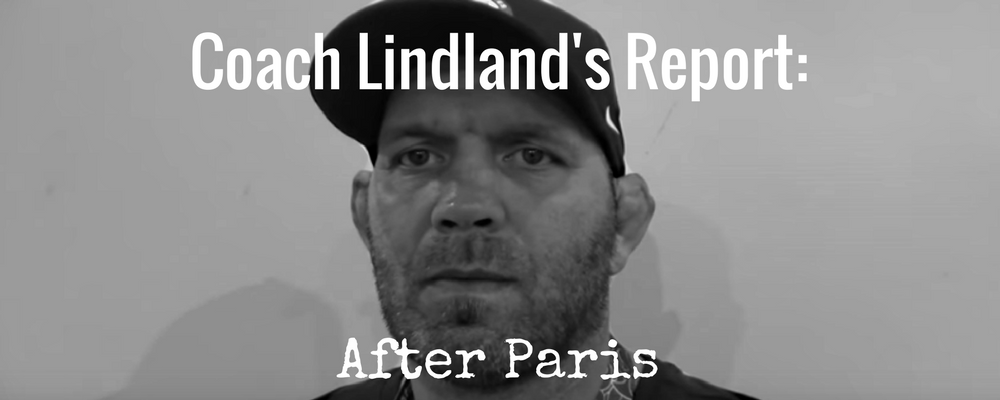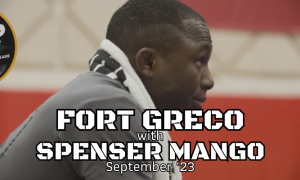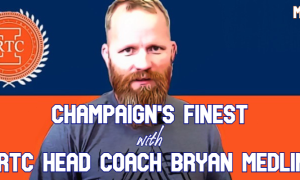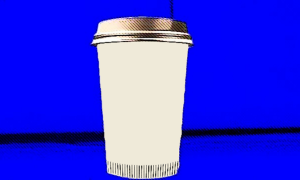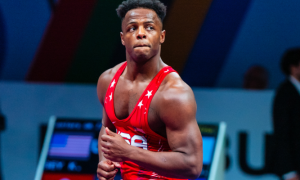Five Point Move is proud to host US Greco-Roman National Team Head Coach Matt Lindland every week for “Coach Lindland’s Report.” For fans and wrestlers looking for insights regarding the US Greco National Team, we ask Coach Lindland questions pertaining to recent events, training, and other topics surrounding the sport of Greco-Roman. If you have any questions of your own you’d like us to ask going forward, let us know via Facebook, Twitter, or through our Contact page.
The 2017 Greco-Roman World Championships last week did not usher in the breakout performances most were hoping for out of the US Seniors, which brought on its share of second-guessing and finger-pointing. After having just shy of seven full days to reflect on the happenings in Paris, US National Team head coach Matt Lindland offers his perspective on the US results and explains in detail why what fans saw last week is still indicative of a bright future. There isn’t a whole lot of soft talk in this report. Accompanying topics such as suffering and sacrifice, what goes into being part of the team, and why developmental support is so valuable are all included. If you had questions about the Seniors following last week, chances are they are all answered right here.
5PM: Now that you’ve had about a week, how have you processed your emotions? Are you disappointed? Are you discouraged? Or on the flipside, are you encouraged and actually see a positive coming out of Paris?
Coach Matt Lindland: Everyone wants to see results. I think one of the more disappointing things was that there were some performances that weren’t up to our guys’ best abilities. I think some of our guys fought up to their abilities and came up a little short. Guys like Tracy (G’Angelo Hancock), who wrestled an Olympic champion and now a three-time World champion and arguably one of the best guys in the sport. What was really great to see about that is that we’ve seen (Artur) Aleksanyan. You’d say, He’s a got a nice arm drag, he’s got an underhook he can drive you off the mat with for one point and if he gets on top, he’s going to gut you, but he doesn’t have a lot of tools. That’s actually not true (laughs). The guy has got a lot of tools and Tracy made him have to use those tools, and that was fun to watch. That was fun to see, to watch Tracy go out there and compete with the best guy in the world and force him to have to use those other tools. So I got to see how good Artur really, really is. I know he’s a great competitor and he’s an incredible wrestler, but he also has a lot more tools in his bag than he really shows at the competitions. Unless he’s forced to. So that was fun to watch.
But again, I am not too hung up on the results because I feel like we’re going in the right direction, we just might not have gone far enough. So it’s not, Go home and regroup. I mean, I’ve heard some other people go, Oh, back to the drawing board. No, that’s not necessarily the case. We are absolutely going in the right direction. We saw the results at the Juniors with the World champ (Kamal Bey). We know we have two other guys who earned medals last year at the Juniors (Taylor LaMont and Hancock). We have the guys in place.
I was just thinking, If we could have these new weight classes for U23’s, we could put together one of the best teams the US has ever put on the mat. 55 (kilograms), we have a few guys and then you start breaking it down: LaMont at 60, (Hayden) Tuma at 63, (Alex) Sancho at 67… 72 is kind of open at the U23’s, but I think (Alex) Mossing is probably your guy, (Colin) Schubert is definitely in there, as is Anthonie Linares. There are some guys in there at that weight. (Mason) Manville at 77, move Bey up to 82, you’ve got (Jon Jay) Chavez at 87, or maybe you throw (Wyatt) Koelling in there… We’re starting to see depth. Hancock at 97, at 130 you have (Nick) Boykin or (Michael) Rodgers. We’re really starting to build some depth at the younger-than-23 age group and some of these guys are still Juniors. LaMont has another year of Junior eligibility. We’re rebuilding and reloading this age group as well, and these athletes are now matriculating onto the Senior level. The U23’s is essentially a Senior tournament, really.
It’s unfortunate we don’t get to apply those new rules until January of 2018, but if you can see what I see, you’d notice the talent is in the pipeline and that these young guys are willing to fight. They are willing to go out there and compete hard and throw everything at their opponents. I mean, look at Manville’s match. If he would have just turned that guy when he got the first takedown, or if there would have been another second on the clock, he could have gotten the knee down. We’re right there with some of those guys.
No, I’m definitely not disappointed and I’m not about to point fingers or place blame on anybody. I’m the head coach and it’s my job and my goal to get results. But it’s also my job to care for and protect these guys, and help them reach their potential and find a way to get them there. There are a lot of things that takes and one of them is right now, a little more time overseas getting experience. We’re doing those things and getting results, we’re winning matches. But we have to put it together at the right time on the right day, and that’s at the World Championships. I know we are headed in the right direction and it’s at ramming speed (laughs). Just keep going forward. I think it’s an exciting time. It’s always darkest before the dawn, right? It sounds cliché, but it’s true. We’re right about to have that breakthrough team and it’s early in the quad. We’re moving into 2020 in a good place.
5PM: When fans think about Greco-Roman power countries overseas, they tend to think of them in terms of dynasties, the constant development and replenishment of capable athletes. What does building a dynasty entail for this country, given its perceived advantages and disadvantages?
ML: I think it depends on how you define the word “dynasty.” It is not just a program, it is something that is sustainable over a long period of time, whether it’s a civilization or a company, or a team. It is something where an organization is not only dominant, but dominant for decades or centuries to earn that kind of a label. Just like anything worth doing, there is no instant gratification. We’re in a world where if you want information, you go to Google and you get 100 results. If you want to communicate, you go on Twitter and someone gets back to you immediately. That’s just not going after anything of magnitude or a big project. We’re not just trying to win, we are trying to build something from the ground up that is going to be sustainable for decades into the future. I’m a builder and I think that is one of the things we were created to do in the image of God, to build as men. So I want to build something that is going to last, that is going to be sustainable long after I’m here.
I work with Jack Stark, he’s been my sports psychologist since I was a junior in college. He worked with me through the Olympic Games and he worked with me throughout my MMA career. When he heard I got this job, he said, “How can I help?” In Jack’s book The Championship Formula, he talks about it and it’s about the four P’s — getting the right people, the right personality traits, the process, and the purpose in place. Each one of those things absolutely matters. You have to have a why? I think one of the most-viewed YouTube videos is of Simon Sinek talking about knowing your why. What’s your purpose? My purpose is to help young men achieve something that is beyond their reach, even. I know these guys all talk like they are capable of doing it, but deep down, I want them to know that they are capable. To understand that they have the abilities within them. There is not one guy on this team who isn’t better than I was at my best time, Tim. We’ve got such talented guys in our program, they just need to learn to believe they are capable of achieving extraordinary things. That is really what it’s about.
5PM: Not long ago, you broke out the quote that “You have to know what it is you’re willing to suffer for.” How does that tie into all of this, the building, the sustenance, and an athlete realizing his abilities?
ML: Yeah, we’ve covered that before and I know for a fact you quoted it and put it out there. It’s a pretty good quote (laughs). And it’s so literal, you have to know what it is you’re willing to suffer for because there is a lot of suffering that goes on in this sport. I had a coach who once told me, “PAT is your best friend — pain, agony, and torture.” You have to learn to dance with it because there is a lot of pain and agony, and it’s a very difficult sport. Maybe that’s why the numbers are declining overall, because you have people who are training athletes in this sport and the athletes don’t have a reason why. They don’t know what it is they want out of this sport, they don’t have a destination. All they know is, This is such a hard, difficult sport, why am I getting my ass kicked day in and day out?
I’ll tell you a little bit about my experience in this sport. I got in kind of late, I was a freshman in gym class. They used the gym class to build a team. Yeah, you’re pretty good at this wrestling thing, you should go out. I was like, Okay, because I was 100 pounds, there was no one else at my weight class who had any muscle mass or any strength or skills, or anything. Yeah, I was fairly decent at wrestling because there was literally no competition at my weight class. And I still struggled and I still got beat my freshman year.
The one thing my coach did was he gave me this flyer about “Roman-Greco”, so I asked the assistant coach if he knew anything about this Roman-Greco thing and he said, “I know enough that it’s Greco-Roman, Matt.” He said if I wanted to do it, that it was tough. That I could end the season right now and go do something else, or I could step into this international style of wrestling. I went into this tournament and wound up 0-8 in a weekend. So you say, How is this possible? You went into one tournament and you went 0-8? Well, I entered freestyle and Greco at the Cadet division, and then I entered freestyle and Greco at the Junior division. That’s how it’s possible, and I went 0-8.
The next Monday, I was taking a bus from my high school 45 minutes away to the town center, then I transferred to another bus for another 15 minutes and when I got off that bus, I jogged it another mile and I went into the club. When I stepped inside, we’re doing neck bridges as warm-ups and I’m getting kicked by kids in the head. They’re like, What the heck are you doing here? For the next four years, to this day I would call them friends, but they were just assholes. They were literally assholes who would try to make me quit for four years. And I was never one of the best guys on that team. We had World champions who came out of that room and multiple Olympians, but ultimately, I was the only guy out of that club who ever earned an Olympic medal. We had really good guys, talented, talented athletes, guys who were on multiple World and Olympic teams, we even had a Senior freestyle World champ out of my club. There were a lot of guys in that program and I was just willing to stay there and get beat up because I wanted to do this. I wanted to have success.
Like I say here, it isn’t that we rejoice in our suffering, but we know that suffering produces perseverance, character, and the hope that someday, I can possibly get better. In James 1:12, he talks about “Blessed is the man who perseveres under trial, because when he has stood the test, he will receive the crown of life that God has promised to those who love Him.” That really talks about salvation and eternity, but you can take that literally, as well, and say perseverance under trials and being tested, you will receive your reward. Whatever that reward is. Maybe it’s not a medal. Maybe it’s the satisfaction that you gave everything you had to give to be the best in the world. And if that’s what you come away with, you can be completely satisfied with that. I didn’t set out to win two silver medals, I set out to be the best in the world, and I came up short. It’s reality. To this day, I still feel like I didn’t reach my goal to be the best in the world but ultimately, I have no regrets, either, and that is what I mean by persevering.
How do you develop strong men? Strong on the mat, strong mentally, strong spiritually, strong men, without testing them in trials? It’s definitely a process.
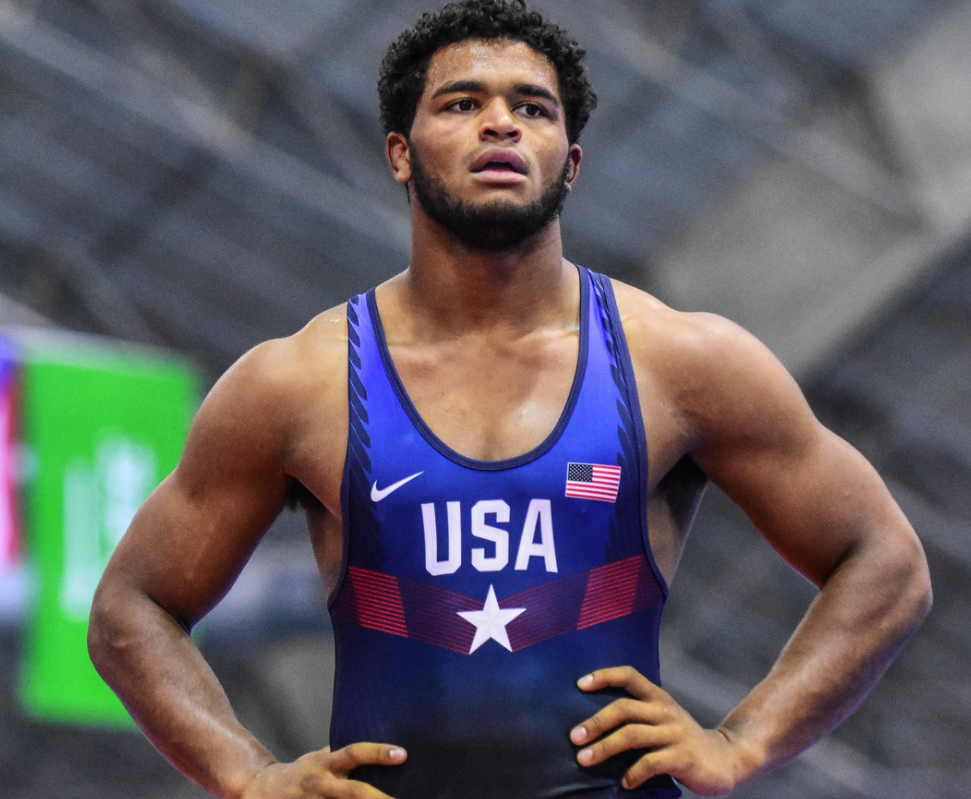
Hancock, shown here at the Junior World Championships, impressed US coach Matt Lindland with his performance against Armenia’s Artur Aleksanyan at the Senior World Championships in Paris, France last week. (Photo: Richard Immel/USA Wrestling)
5PM: Okay, then how about related to the growth such suffering is supposed to be responsible for? Is there a process of sorts that comes along with that? A process athletes have to endure, a set of steps you believe in?
Coach Matt Lindland: Yeah, my title is “National coach”, but I feel like my role is to develop men, hard, tough men who are willing to endure whatever it takes and there is definitely a process to develop that hardness. But you’re not hard and brittle, though. It’s like a blacksmith. When he is blacksmithing material, he is tempering that material not only to make it hard, but also to make it have flexibility. Imagine if you were just hard, but brittle. You’re going to break. We talk about that flexibility, that suppleness, being like water and in martial arts, it’s all about bending with the wind and moving like water. One of the processes I like to use as an example was back when I was a young man and an equestrian athlete, we weren’t a very wealthy family and I wanted to get my horses shoed, so my dad took me to a class. I think I was 12 years old, I took a class at the community college with my dad to learn how to blacksmith. A blacksmith follows a six-step process and it takes time, effort, resilience, but anything where you want to reach a goal requires that.
The blacksmith follows the six-step process of self-discipline to reach his goals and it’s the only road to quality, lasting achievement. The raw iron a blacksmith uses to create his works of art is a necessity much like the raw potential of an individual in so far that it has to be molded into the desirable state. It is a process that begins with a purpose — what do you want to accomplish? Which in turn sparks a vision of the goal. The experienced blacksmith knows he can reach his goals because he has spent years preparing himself to do so.
As an apprentice, we learn by watching the master, since the master was successful, the apprentice realized that doing the job was possible and he realized that he could do it, too, provided he has gained the skills. But he learned to build his fire to exactly the right temperature — glowing red, and hot enough to mold the metal into the vision he had first created in his mind. Finally, he stays with the task until it is finished, perfectly matching his vision.
To put it simply, people who reject the value of instant gratification and develop the skill of self-discipline are life’s real winners. These people have developed “emotional intelligence. They are able to set goals and harness the motivational strength to see it through to their successful fruition day by day, week by week, month by month, and year by year. They know any worthwhile achievement takes time and sustained effort.They are willing to pay the price they are willing to suffer to get the desired outcome. These men are self-starters, doers, and finishers.
5PM: I’d be remiss not to ask about the six steps.
ML: Okay, the first step is forging, which is the process of heat and hammering the raw material into the form you envisioned. This process is done over time, heating and cooling the raw material. Then you see the form beginning to take shape there is still a lot of work to be done. The raw material may start to take form and look like what the blacksmith is envisioning, but the metal is brittle and prone to break. The next step is annealing, which requires heating and slowly cooling to make the material soft and easier to grind into the desired shape and form. This is the process of toughening or tempering. This makes the material strong and also flexible so it doesn’t break. This can be a long, slow process. I feel this is where we are at in the process of molding the next generation of Greco-Roman warriors.
Third is grinding. The blacksmith uses the grinder to work out the final shape, although the material is still too soft. Fourth would be hardening. This is the process we have seen in the movies where the sword is heated to a high temperature and placed in water to cool quickly and evenly in order to harden the material. This is where the metal starts to demonstrate integrity and strength, although it is still too brittle. Five is tempering once more. The material is again heated, this time at a much lower temperature and then cooled. This heating and quenching process takes time and must be repeated many times. It also requires a master blacksmith and you have to have a trained hand-and-eye to understand this part of the process.
Finally, six is competition. Now your raw material is done and you can add the additional bling. This is the same process the athletes must go through. We talk about the process as if it’s a cliché, but it’s true. The athletes have to embrace the process just as the blacksmith does. Rejecting the idea of instant gratification and develop the necessary skills and self-discipline. They must be able set goals and harness the motivation, strength and character to see it through to their successful fruition day-by-day, week-by-week, and year-by-year. They have to understand that any worthwhile achievement takes time and sustained effort.
5PM: What about the theme for the quad, everyone in the boat paddling together towards the same goal? What is the difference between being on the team and a part of the team, and how those functions are relative to one another?
ML: I think that is the crux of what we are trying to get across, which is even if you’re in the red boat — guys who step on the mat at the Worlds or the Olympic Games — or in the white or blue boat, you have the opportunity to serve and contribute. My staff and I, we work extremely hard to create that kind of environment. We care about the athletes and we care about the creating the right environment. We’re leading by example and saying, We’re in this with you. We’re in this every step of the way and here to help you succeed. But help us help you. We cannot want it more than the athletes do, it just doesn’t work that way. The athletes have to want not just to win, but like we talked about earlier, to build a dynastic program. The All Blacks talk about planting trees. They are a dynasty when it comes to rugby, there is no other program you think about when it comes to rugby. They talk about planting trees, that’s what they talk about when they say leaving a legacy, something for the next generation to stand on.
I think the guys who came before us, the Dennis Hall’s, the Brandon Paulson’s, the Garrett Lowney’s, the Rulon Gardner’s, Brad Vering, Justin Ruiz, Joe Warren — the guys who won for the United States were tough dudes, they were badass guys who fought. Go watch 1995 World Championships Dennis Hall. That guy beat four World champions. He didn’t get a good draw (laughs). He fought. He fought every single one of those guys. But all of our guys who had success, that was the one quality. These foreigners, they’re going to beat us technically. They are going to be a little more ahead of us technically because they don’t have the same system. They have a Greco-Roman system in their countries.
5PM: What would be an example of everybody being involved pulling in the same direction, but also, being forced to stay in the background? If not everyone can be on the team or in the “red boat”, what would be an example of teammates going that extra mile to help others?
Coach Matt Lindland: I think there are many, many examples and many, many different ways that athletes, coaches, fans, and supporters can contribute. We are a volunteer non-profit organization. Every national governing body functions in that capacity. So we operate off of people giving their time, energy, and resources, sometimes money, and all of those things help us improve. But I think showing up to camp on time and being on the mat ten minutes early if practice starts at three o’clock. Staying after to help the young guy. And I saw some of this stuff. I saw a lot of it and I tried to create that environment this year in our camps. Then maybe someone would criticize and say, Oh, you shouldn’t have your Juniors at your Senior camps or, You shouldn’t have your Cadets at your Junior camps. Or whatever it is. But I think bringing the Cadets into our Junior camps raises their level. I think bringing the Juniors into our Senior camps raises their level, raises where they are at. And if the level isn’t being raised, at least they know where the gap is and that know how far that gap is they have to close.
But really, just contributing. Coach Loukides created an incredible environment in that program and they are fortunate because they have trained leaders. They have guys who have graduated from the Naval Academy who know how to do this. They’re trained, but it’s also who they are. They came to camp and were there to serve and help. We had extra practices for our Cadets during the two weeks Senior camp was going on. We were really getting after it and recovering our guys. We would go hard, and then we would recover. Since the Cadet Worlds were a few weeks after the Senior Worlds, it was like, Well, we can push those Cadets a little harder, we’ve got time. And we weren’t pushing them necessarily, just giving them more volume and more time on the mats.
Those Marines were in there every single practice looking to help. Do you think they are going to get better because they were in there with the other coaches and getting to learn more? Yeah, they’re going to get better. So it wasn’t just, Hey, I’m here to help, but instead, There’s a chance for me to improve. Why wouldn’t you take every opportunity to spend time making yourself better? Then they came to the Montpellier acclimation camp and their whole purpose was to come and serve the team, and they were in the warm-up room in Paris, too. Everything about the Marines was about how they could help serve the team and they didn’t have a single guy on the World Team. But I felt like those guys were just as big of a part of the team as any of those wrestlers representing the United States on the mats last week. I feel like that is a great example to follow.
Another example of selflessness we had recently was four of our athletes moved off complex to make room for younger guys coming in. We just went from four residents to eight residents real quick. When I asked RaVaughn (Perkins), he said, “Coach, whatever you need, I’m here for you.” It was just an attitude of, I’m grateful for the opportunity to be here. I’m not in Omaha, I’m here at the Olympic Training Center pursuing my dreams and if you need me to move off campus, I’ll do it. And he went out and found a place to live, and he’s still a resident, he just doesn’t live on the complex. He’s also 25 years old, do you think a 25-year-old should be living in the dorms? Or should he be out on his own, paying bills, learning life skills, and starting his life as an adult? (Patrick) Martinez was definitely not that eager to move, but when I told him that was what I needed to do, he said, “I’m willing to help and if that’s what I have to do, I’ll do it because I want to be a part of this team.”
We’re seeing that kind of attitude, I just want to see it more. I want to see it consistently from everyone in the program, not just from a few guys. But I think if enough athletes set that example, it just becomes part of the culture. It becomes the way we do things. It’s going to happen. We’re going to see more guys be selflessly step up to serve and be part of the team, no matter what it means for that individual.
5PM: I don’t know how much you paid attention to fans and media while you were over in Paris, but assuming you did at least a little, do you think people overreacted a bit regarding the US performances?
Coach Matt Lindland: Well, frankly, I don’t really follow the social media quite like that. I’m on it, I put messages out, and I try to stay engaged, but during those times, I try to intentionally stay away unless it’s freestyle and women’s results. I’m a huge fan of the United States and I’m a huge fan of wrestling, period, so I tried to follow those. But as for the wrestling community as a whole, unless you are a fan of our program or you are involved with our program, it’s the same message that I’m talking about. Just because you’re not on the World team doesn’t mean there isn’t a way for you to contribute and serve. If you’re part of the wrestling community and you’re being critical and have judgement, whatever that is, where can you serve? Where can you step up? Where can you help us? Those are the questions you should be asking of yourself instead of being critical of our program because we have a lot of challenges that the freestyle program doesn’t have. We have a lot of different challenges. Some of them are similar. The developmental culture, I think that is something problematic across the board. But there is no question, I don’t think anyone would disagree that Greco-Roman has different challenges than freestyle in our country. And also, freestyle hadn’t won the World Championships since 1995, either. But they had been trending in the right direction. It’s the same trajectory I see the Greco-Roman program on. We’ve had some Junior success. We’ll have some more Junior success. Now we’re going to have some U23 success.
5PM: You’re going to have some Cadet success.
ML: We’re going to have some Cadet success next week (laughs). I’m so excited to go out to the Cadets to see these young men compete. These guys are fighters. I had the opportunity to watch them at camp and I spent more time with our Cadet athletes this year than I ever have since I became the National Team coach. It was, Let’s get our Juniors going, okay, now they’re going; Let’s get our Cadets going… This year, I am going to go to the Cadet World Championships, it’s my third year and I finally have that opportunity and be a part of that. I’m excited.
We are headed in that same trajectory. There are challenges, but if there are people out there talking, the only talking they should be doing is asking, How can I help? How can I serve and contribute to the program? If you’re wrestling fans, that should be weighing on your soul, on your conscience, saying, What can I do? I think that’s the message. Is that your question?
5PM: Yes, but I know it’s probably not something you would normally be concerned with.
ML: Or paying attention to. It’s not a concern. But you’re right, for those people who are talking, wouldn’t it be great if they were talking about how they can contribute? How they can serve and help us?
5PM: Right. Well, they might be singing a different tune with the Cadets. This looks to be a solid team taking the mat in Athens next week with two returning members and a host of other kids who have made names for themselves before this year. This seems like it would be indicative of that right direction you talk about, one age group feeding the next one up eventually or at least, hopefully, right?
Coach Matt Lindland: I definitely think it’s two-fold. I think that yes, it is showing that things are headed in the right direction when you have a talented pipeline. But the biggest disappointment is that every year, these athletes, I lose them. They go to their high schools, they go to the national prep tournaments, the fake national preseason tournaments, the Christmas nationals, the fake postseason tournaments, the fake Reno Worlds — all of these fake titles that they get and it’s disheartening because I see these guys and they are Greco-Roman wrestlers and that’s why they’re on the team. Other guys are just really tough, tough dudes who could be successful in any style. My job is to help them fall in love with Greco-Roman because they are really, really tough, talented dudes who could develop into Greco-Roman wrestlers. So that’s why I say it’s a two-fold situation. On one hand, I am excited to work with these athletes and matriculate them into our Junior and Senior pipeline. But it’s disheartening when they want to go wrestle for the Jackrabbits or the Gophers. It’s frustrating to see that.
But that is part of the deal, where I have to spend time with them and go to Greece with them, or I am going to lose them. Somebody is going to let these athletes know they want them to be a part of their program. They’re already in our program.
Be sure to follow Coach Matt Lindland on Facebook, Twitter, and his official blog for updates on the US Greco-Roman Wrestling program.
SUBSCRIBE TO THE FIVE POINT MOVE PODCAST
iTunes | Stitcher | Spreaker | Google Play Music | RSS

Notice: Trying to get property 'term_id' of non-object in /home/fivepointwp/webapps/fivepointwp/wp-content/themes/flex-mag/functions.php on line 999

